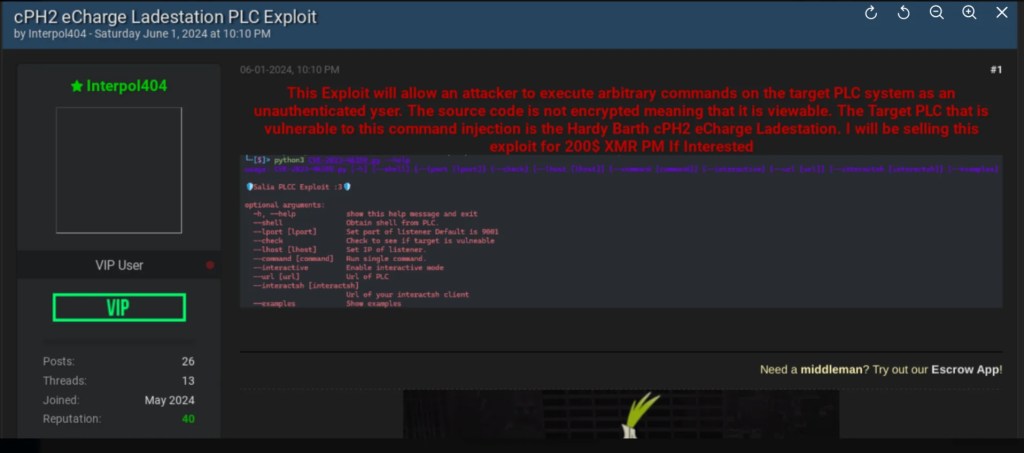Patch CVE-2023-46359: Protect Your EV Charger From Attacks

Additionally, CVE-2023-46359 allows cybercriminals to remotely execute arbitrary commands on the targeted system.
Samiksha Jain June 4th, 2024

Share on LinkedInShare on Twitter
Interpol404, a threat actor (TA) is selling exploit code for a critical security vulnerability (CVE-2023-46359) on the Nuovo BreachForums. The TA has set a price tag of $200 for this vulnerability.
Written in Python, Vulnerability CVE-2023-46359 weaponizes the OS command injection vulnerability, allowing unauthenticated attackers to take full control of the affected system.
Additionally, CVE-2023-46359 allows cybercriminals to remotely execute arbitrary commands on the targeted system. This potentially compromises its functionality, endangering connected devices.
More About CVE-2023-46359
This vulnerability, CVE-2023-46359 has been discovered in the Hardy Barth cPH2 Wallbox. It is a widely used electric vehicle charging station.
The exploit code is reportedly accompanied by a screenshot showcasing its usage, syntax, and argument details. As the exploit code is unencrypted, anyone with access to the forum post can potentially analyze and modify the code for malicious purposes. This is something that raises concern.

Implications of Vulnerability CVE-2023-46359
Exploiting CVE-2023-46359 could have severe consequences. Attackers could potentially:
- Charging Operations Might Get Disrupt: By executing arbitrary commands, attackers could manipulate the Wallbox’s functionality, potentially disrupting charging operations or even damaging connected electric vehicles.
- Launch Further Cyberattacks: Gaining access to the Wallbox could provide a foothold within a network, allowing attackers to launch further attacks on other connected devices.
- Steal Sensitive Data: The Wallbox might store sensitive information such as user credentials or billing details. A successful cyberattack could compromise this data.
Recent discoveries like “Linguistic Lumberjack” (CVE-2024-4323) in Fluent Bit and “TunnelVision” vulnerability within VPNs demonstrate the widespread presence of exploitable weaknesses. Additionally, the high alert issued by the Australian Cyber Security Centre (ACSC) for vulnerabilities in Check Point Gateways (CVE-2024-24919) underlines the critical need for strong cybersecurity measures.
Steps for Mitigating These Risks
Here are some essential steps to help mitigate the risks related to CVE-2023-46359. By following these guidelines, users can lessen the likelihood of their Hardy Barth cPH2 Wallbox being hacked by this important vulnerability.
- Monitor Security Updates: Stay up to date on the newest security risks and updates from Hardy Barth and other relevant cybersecurity agencies.
- Disable Remote Access (if applicable): If the Wallbox includes remote access functionality, consider turning it off unless absolutely necessary. This minimizes the attack surface for potential exploits.
- Patch Systems Immediately: Hardy Barth should issue a patch to remedy this vulnerability as soon as practicable. Users are encouraged to apply the patch as soon as it is released.
- Maintain Strong Passwords: Use strong and unique passwords for all accounts associated with the Wallbox.





